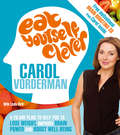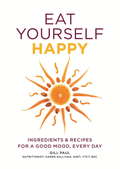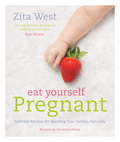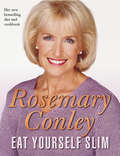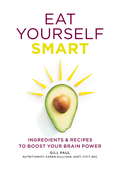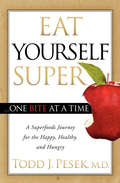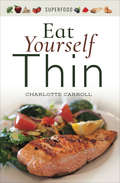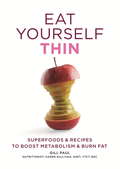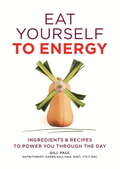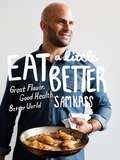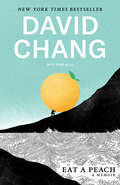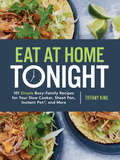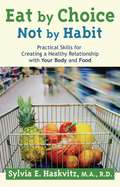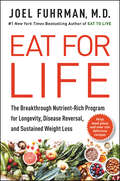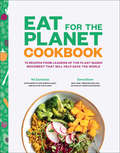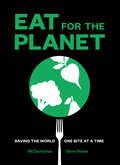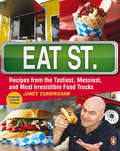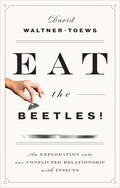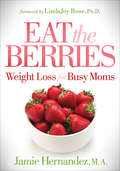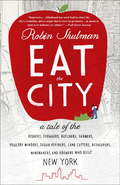- Table View
- List View
Eat Yourself Clever: A 28-Day Plan to Help you Lose Weight, Improve Brain Power and Boost Wellbeing
by Carol Vorderman Linda BirdCarol Vorderman's brand-new 28-day plan will help you get into shape, beat your cravings and exercise your mind, all at the same time.Using foods that lift your mood as well as boosting your brain power, Carol's easy-to-follow plan is the straightforward route to weight loss, better health and increased brain power. Discover how to increase your IQ, improve your memory, beat food cravings, break the cycle of emotional eating.With delicious and simple-to-make recipes, Carol's 28-day plan is guaranteed to dramatically improve your health and boost your mental performance.
Eat Yourself Happy: Ingredients & Recipes for a Good Mood, Every Day
by Gill PaulEat yourself happy with this informative guide to eating right and improving your mind-set.We all feel low and discouraged from time to time, but when these feelings continue for weeks and even months, it's time to do something about it.There are dozens of different types of depression, with different causes, but almost all are improved by eating the right kinds of foods to synthesise ample supplies of brain neurotransmitters, address vitamin and mineral deficiencies and stabilise blood sugar levels.It's important not to choose sugary foods that offer a quick burst of energy and alcoholic drinks that dull the pain - these will both make depression worse. No matter how you feel, making wise food choices will help - and you'll feel the benefits start straight away.Featured in this book are the key foods that have been proven to increase the feeling of wellbeing in our minds and bodies. A clever problem-solver helps you choose the ingredients that address your symptoms, and the results are immediate.With over 60 easy-to-follow, quick-to-prepare, completely delicious recipes, and weekly meal planners, Eat Yourself Happy is the perfect way to boost your mood and achieve optimum health.Eat Yourself Happy includes...Part I Happy SuperfoodsSuperfoodsWhat's your problem?Putting it all togetherPart IIHappy RecipesBreakfastSnacksLunch DinnerDesserts...And much much more!
Eat Yourself Happy: Ingredients & Recipes for a Good Mood, Every Day (Eat Yourself)
by Gill PaulEat yourself happy with this informative guide to eating right and improving your mind-set.We all feel low and discouraged from time to time, but when these feelings continue for weeks and even months, it's time to do something about it.There are dozens of different types of depression, with different causes, but almost all are improved by eating the right kinds of foods to synthesise ample supplies of brain neurotransmitters, address vitamin and mineral deficiencies and stabilise blood sugar levels.It's important not to choose sugary foods that offer a quick burst of energy and alcoholic drinks that dull the pain - these will both make depression worse. No matter how you feel, making wise food choices will help - and you'll feel the benefits start straight away.Featured in this book are the key foods that have been proven to increase the feeling of wellbeing in our minds and bodies. A clever problem-solver helps you choose the ingredients that address your symptoms, and the results are immediate.With over 60 easy-to-follow, quick-to-prepare, completely delicious recipes, and weekly meal planners, Eat Yourself Happy is the perfect way to boost your mood and achieve optimum health.Eat Yourself Happy includes...Part I Happy SuperfoodsSuperfoodsWhat's your problem?Putting it all togetherPart IIHappy RecipesBreakfastSnacksLunch DinnerDesserts...And much much more!
Eat Yourself Pregnant
by Zita WestZita West, midwife to Cate Blanchett, Stella McCartney and Kate Winslet, shares her expertise in nutrition to help you and your baby stay healthy naturally throughout your pregnancy. It is crucial to eat an optimum diet during pregnancy. Your levels of nutrients need to be high in order to support you through the process of pregnancy, and the baby that you're carrying inside of you needs the full range of nutrients to be as healthy as possible. It can be difficult and tiring to make nutrient-filled meals, but Zita gives you clear information and simple, easy-to-make recipes. The first section of the book covers details such as what nutrients are important and what they do for you and your baby, and foods that are unhealthy to consume during pregnancy. The second section uses the vitamins and nutrients explained in the first section in 80 delicious recipes. Introduction Your Health (nutrients your body needs as it changes, sources of these nutrients, foods that help with the side effects of pregnancy, the importance of safe exercise) Your Baby's Health (nutrients your baby needs to grow, what they do, sources of these nutrients) What to Avoid (foods not to eat why they are bad for you and your baby) Breakfasts Light Meals Snacks and Treats Main Meals Desserts.From the Trade Paperback edition.
Eat Yourself Pregnant
by Zitz WestZita West, midwife to Cate Blanchett, Stella McCartney and Kate Winslet, shares her expertise in nutrition to help you and your baby stay healthy naturally throughout your pregnancy. It is crucial to eat an optimum diet during pregnancy. Your levels of nutrients need to be high in order to support you through the process of pregnancy, and the baby that you're carrying inside of you needs the full range of nutrients to be as healthy as possible. It can be difficult and tiring to make nutrient-filled meals, but Zita gives you clear information and simple, easy-to-make recipes. The first section of the book covers details such as what nutrients are important and what they do for you and your baby, and foods that are unhealthy to consume during pregnancy. The second section uses the vitamins and nutrients explained in the first section in 80 delicious recipes. Introduction Your Health (nutrients your body needs as it changes, sources of these nutrients, foods that help with the side effects of pregnancy, the importance of safe exercise) Your Baby's Health (nutrients your baby needs to grow, what they do, sources of these nutrients) What to Avoid (foods not to eat why they are bad for you and your baby) Breakfasts Light Meals Snacks and Treats Main Meals Desserts.From the Trade Paperback edition.
Eat Yourself Slim
by Rosemary ConleyWhether you are a vegetarian or a meat-eater, want to cook a snack or prepare a dinner party, Eat Yourself Slim includes a wide variety of recipes and meal suggestions to choose from. The book shows you how you can calculate your personal basal metabolic rate - ie how many calories your body needs to function properly - which helps you work out the level of eating that will optimise your weight loss, while not leaving you hungry. You won't feel deprived - you're even allowed a high-fat treat every day!But losing weight and staying slim isn't just about eating fewer calories and less fat. It's about finding the will power and getting your head into gear, so Eat Yourself Slim includes lots of motivational tips to help with that too. Full of delicious low-fat recipes suitable for you and all the family as well as dinner party guests, you won't even notice you're on a diet! There really is something for everyone.Cooking healthily, losing weight and keeping it off has never been so simple. Enjoy the journey and revel in your ultimate success.
Eat Yourself Smart: Ingredients and recipes to boost your brain power
by Gill PaulIf you have trouble concentrating, coming up with ideas or thinking clearly, eating more of the brain-activity-enhancing foods in this book can help. Featured in this book are the key foods that have been proven to benefit brain functions: beetroot, brown rice, coffee, kidney beans, pecans and strawberries among other tasty ingredients. A clever problem-solver helps you choose the ingredients that bring benefits ranging from mental alertness, longer attention span and restful sleep to prevention of dementia.With over 60 easy-to-follow, quick-to-prepare, completely delicious recipes, and weekly meal planners, Eat Yourself Smart is the perfect way to cook yourself clever and achieve optimum health.
Eat Yourself Smart: Ingredients and recipes to boost your brain power (Eat Yourself)
by Gill PaulStimulate your little grey cells with these delicious brain-booster foods.
Eat Yourself Super . . . One Bite at a Time: A Superfoods Journey for the Happy, Healthy, and Hungry
by Todd J. PesekGet started on the road to wellness and longevity with foods that serve as natural, nutritional powerhouses in cultures and traditions around the world. Eat Yourself Super . . . One Bite at a Time seeks to educate readers about Superfoods: what they are, where to find them, how much to eat, and how to prepare them. Using Dr. Todd&’s Superfoods Pyramid and Secrets of Long Life research as the basis for this discussion, it shows readers how current scientific and medical research echoes the Doc&’s finding on longevity and vital living cross-culturally, through the Superfoods diet. Each level of the pyramid has its own chapter in the book, where the function and benefits of the foods featured on that level are explained. In addition, you will learn about the need for sunshine, pure water, balance, and reflection, and indulge in a large number of easy to prepare recipes accommodating to all ability levels. Dr. Todd&’s family prepares foods from these recipes every day, and they feel good about inviting readers to join the Superfoods table.
Eat Yourself Thin (Superfood)
by Charlotte Carroll&“No fad diet or banning of food groups—this is about changing your relationship with food and exercise . . . to help you keep the weight off for good&” (The Sun). Would you set aside time each day for the next week or two if it helped transform your body and life and helped you lose the weight that you want? If so, then read on! Diets come and go but medical advice on what constitutes as a good diet has stayed exactly the same, and this book promotes changing your lifestyle for the better through positive reinforcement about how we view ourselves and food. It includes diets from around the world that influence our own eating habits, healthy lifestyle swaps, the triggers to why we eat, and how to overcome any barriers we are feeling around weight loss. Think fats and carbs are bad for you? Find out how they can actually be part of a healthy balanced diet! With edible flower ice lolly recipes and unique alternate therapies, this book will help each individual achieve their goals. Eat Yourself Thin has been written so that readers feel good about themselves, through changing their mindset and how we think about foods and diets. There are facts, studies, healthy recipes, and personal experiences with plenty of humor thrown in. After all, weight loss can be a struggle with cravings, urges, and stress—and laugher is always the best medicine!
Eat Yourself Thin: Superfoods & Recipes to Boost Metabolism & Burn Fat
by Gill PaulEat yourself thin with this informative guide to eating the right food to keep weight off and stay thin.'Eating yourself thin' might sound odd when it's eating that made you overweight in the first place. It's not the process of eating that does the harm, however, but eating too much of the wrong kind of foods. Once you start focusing on foods that make your digestive, hormonal and cardiovascular systems work at optimum level, losing weight and keeping it off long term needn't be an uphill struggle.The key to getting thin, and staying thin, is restoring balance to key hormones in your body. A diet of low-GI foods will deliver this. You don't need to obsess about calories, and you might even find yourself eating more than you did previously. The important thing is to change the types of food you eat, and change them for good. There are many different reasons for being overweight - from post-pregnancy pounds to stress - and you will find here lists of foods that are particularly useful in solving any problems you may be experiencing.So follow the menu planners and these delicious recipes to change the way you eat, and the way you look, forever.Eat Yourself Thin includes...Part I Happy SuperfoodsSuperfoodsWhat's your problem?Putting it all togetherPart IIThin RecipesBreakfastSnacksLunch DinnerDesserts...And much much more!
Eat Yourself Thin: Superfoods & Recipes to Boost Metabolism & Burn Fat (Eat Yourself)
by Gill PaulEat yourself thin with this informative guide to eating the right food to keep weight off and stay thin.'Eating yourself thin' might sound odd when it's eating that made you overweight in the first place. It's not the process of eating that does the harm, however, but eating too much of the wrong kind of foods. Once you start focusing on foods that make your digestive, hormonal and cardiovascular systems work at optimum level, losing weight and keeping it off long term needn't be an uphill struggle.The key to getting thin, and staying thin, is restoring balance to key hormones in your body. A diet of low-GI foods will deliver this. You don't need to obsess about calories, and you might even find yourself eating more than you did previously. The important thing is to change the types of food you eat, and change them for good. There are many different reasons for being overweight - from post-pregnancy pounds to stress - and you will find here lists of foods that are particularly useful in solving any problems you may be experiencing.So follow the menu planners and these delicious recipes to change the way you eat, and the way you look, forever.Eat Yourself Thin includes...Part I Happy SuperfoodsSuperfoodsWhat's your problem?Putting it all togetherPart IIThin RecipesBreakfastSnacksLunch DinnerDesserts...And much much more!
Eat Yourself to Energy: Ingredients & Recipes to Power You Through the Day
by Gill PaulEat yourself energetic with this informative guide to eating right and boosting your energy levels.Do you drag yourself out of bed in the morning, yawn through the working day, then collapse in front of the TV in the evening? We all feel exhausted from time to time but when that feeling continues, it's time to do something about it.There are excellent ways of eating yourself to energy which also boost overall health. Avoid being tempted by quick-fix caffeine or sugary 'energy' drinks and bars, focus instead on foods that keep blood sugar levels steady. By addressing the underlying causes of low energy, you will achieve lasting results.The Eat Yourself to Energy diet contains all the vitamins, minerals and trace elements you need to ease niggling health problems and make you feel tip-top and raring to go.Featured in this book are the key foods that have been proven to increase stamina and boost energy. A clever problem-solver helps you choose the ingredients that adress your own individual symptoms, and the results are immediate.With over 60 easy-to-follow, quick-to-prepare, completely delicious recipes, and weekly meal planners, Eat Yourself to Energy is the perfect way to turbo-charge your mood and achieve optimum health.Eat Yourself to Energy includes...Part I Happy SuperfoodsSuperfoodsWhat's your problem?Putting it all togetherPart IIEnergy RecipesBreakfastSnacksLunch DinnerDesserts...And much much more!
Eat Yourself to Energy: Ingredients & Recipes to Power You Through the Day (Eat Yourself)
by Gill PaulEat yourself energetic with this informative guide to eating right and boosting your energy levels.Do you drag yourself out of bed in the morning, yawn through the working day, then collapse in front of the TV in the evening? We all feel exhausted from time to time but when that feeling continues, it's time to do something about it.There are excellent ways of eating yourself to energy which also boost overall health. Avoid being tempted by quick-fix caffeine or sugary 'energy' drinks and bars, focus instead on foods that keep blood sugar levels steady. By addressing the underlying causes of low energy, you will achieve lasting results.The Eat Yourself to Energy diet contains all the vitamins, minerals and trace elements you need to ease niggling health problems and make you feel tip-top and raring to go.Featured in this book are the key foods that have been proven to increase stamina and boost energy. A clever problem-solver helps you choose the ingredients that adress your own individual symptoms, and the results are immediate.With over 60 easy-to-follow, quick-to-prepare, completely delicious recipes, and weekly meal planners, Eat Yourself to Energy is the perfect way to turbo-charge your mood and achieve optimum health.Eat Yourself to Energy includes...Part I Happy SuperfoodsSuperfoodsWhat's your problem?Putting it all togetherPart IIEnergy RecipesBreakfastSnacksLunch DinnerDesserts...And much much more!
Eat a Little Better: Great Flavor, Good Health, Better World
by Sam KassSam Kass, former chef to the Obamas and White House food policy advisor, makes it easier to do a little better for your diet--and the environment--every day, through smart ways to think about shopping, setting up your kitchen so the healthy stuff comes to hand most naturally, and through 90 delicious, simple recipes.This book lays out Kass's plan to eat a little better. Knowing that sustainability and healthfulness come most, well, sustainably when new habits and choices seem appealing rather than drastic and punitive, Kass shares his philosophy and methods to help make it easy to choose, cook, and eat delicious foods without depriving yourself of agency or pleasure. He knows that going organic, local, and so forth all the time is just not realistic for most people, and that's ok--it's all about choosing and doing a little better, and how those choices add up to big change. It's the philosophy he helped the Obamas instill in their home, both in Chicago and that big white one in Washington.
Eat a Peach: A Memoir
by David Chang Gabe UllaFrom the chef behind Momofuku and star of Netflix&’s Ugly Delicious—an intimate account of the making of a chef, the story of the modern restaurant world that he helped shape, and how he discovered that success can be much harder to understand than failure.&“David puts words to so many of the things we all feel, sharing generously of his own journey so we can all benefit in the process.&”—Chrissy TeigenIn 2004, Momofuku Noodle Bar opened in a tiny, stark space in Manhattan&’s East Village. Its young chef-owner, David Chang, worked the line, serving ramen and pork buns to a mix of fellow restaurant cooks and confused diners whose idea of ramen was instant noodles in Styrofoam cups. It would have been impossible to know it at the time—and certainly Chang would have bet against himself—but he, who had failed at almost every endeavor in his life, was about to become one of the most influential chefs of his generation, driven by the question, &“What if the underground could become the mainstream?&” Chang grew up the youngest son of a deeply religious Korean American family in Virginia. Graduating college aimless and depressed, he fled the States for Japan, hoping to find some sense of belonging. While teaching English in a backwater town, he experienced the highs of his first full-blown manic episode, and began to think that the cooking and sharing of food could give him both purpose and agency in his life. Full of grace, candor, grit, and humor, Eat a Peach chronicles Chang&’s switchback path. He lays bare his mistakes and wonders about his extraordinary luck as he recounts the improbable series of events that led him to the top of his profession. He wrestles with his lifelong feelings of otherness and inadequacy, explores the mental illness that almost killed him, and finds hope in the shared value of deliciousness. Along the way, Chang gives us a penetrating look at restaurant life, in which he balances his deep love for the kitchen with unflinching honesty about the industry&’s history of brutishness and its uncertain future.
Eat at Home Tonight: 101 Simple Busy-Family Recipes for Your Slow Cooker, Sheet Pan, Instant Pot®, and More
by Tiffany KingFounder of the Eat at Home website and family meal-planning wizard Tiffany King shares recipes focused on simplicity, flavor, and healthy balance to help home cooks end every day with an affordable family dinner.A popular food blogger with 8.5 million page views, Tiffany King's debut cookbook is crafted for those nights "when life happens." This is the cookbook to turn to when all hope of a homemade, wholesome dinner seems lost: when the fridge is empty, when it's already 8pm, when one kid has soccer practice and the other dance, when there's no time for cleanup because homework has to get done. Just like her blog, King's book is tirelessly encouraging and realistic. The recipes feature bright vegetables and affordable pantry ingredients. The book, uniquely arranged by "excuses," includes sidebars with mealtime conversation starters and helpful cooking hints.
Eat by Choice, Not by Habit
by Sylvia HaskvitzCombining sound dietary information with the techniques of the Nonviolent Communication (NVC) process, this booklet shifts the focus from simple weight loss to changing the ways readers relate to food and their food choices. Eating is a need, but for those caught in cycles of overconsumption and dieting, it's often a poor attempt to meet other needs, such as emotional fulfillment. When reconnected to actual needs, however, consumption habits turn into nutritional choices, signaling greater freedom. Practical strategies are outlined for breaking out of cycles of eating and becoming aware of one's needs. Rather than being a proscriptive fad diet, the suggestions encourage readers to explore the emotional consciousness that underlies their eating patterns, freeing them to once again enjoy the tastes, smells, and sensations of good eating.
Eat for Life: The Breakthrough Nutrient-Rich Program for Longevity, Disease Reversal, and Sustained Weight Loss (Eat for Life)
by Joel Fuhrman M.D.Add years to your life and life to your years with #1 New York Times bestselling author Dr. Joel Fuhrman no-nonsense, results-driven nutrition plan that will help you look and feel your best inside and out.Eat for Life is the first book to showcase Dr. Joel Fuhrman’s Nutritarian Diet in full—the most practical, balanced, and focused way to eat, lose weight, and live longer. Emphasizing high-nutrient, whole plant foods that supply abundant amounts of micronutrients, it can broken down into a simple equation: H = N/C. Or, Health= Nutrient intake per Calorie consumed. Most Americans are deficient in micronutrients (vitamins and minerals) and consume too many macronutrients (calories). Natural, colorful plant foods contain the largest assortment of micronutrients, including anti-cancer phytochemicals. When consumed in large quantities every day, these plant foods are proven to decrease cravings, reverse the symptoms of nearly every disease, and maintain ideal weight. The Nutrarian Diet helps you shed more pounds, reach lower cholesterol and blood pressure levels, reverse diabetes better, and reduce hunger and cravings more than any other program available.Combining Dr. Fuhrman’s wise food and lifestyle advice with his famously straightforward, practical recipes, Eat for Life is a daily guide to eating well, a healthy cookbook and meal plan, and a blunt kick-in-the-butt to help you take control of your health destiny. All people—sick or healthy, overweight or slim, young or old—can benefit from this plan. Eat for Life will help our bodies to thrive and experience a modern miracle: a long, disease-free life without heart disease, strokes, dementia, or even cancer.”
Eat for the Planet Cookbook: 75 Recipes from Leaders of the Plant-Based Movement That Will Help Save the World
by Gene Stone Nil ZachariasThe entrepreneur/podcaster and the bestselling author of Forks Over Knives serve up delicious planet-friendly, vegan recipes from chefs and innovators.From Nil Zacharias, the cofounder of multiple online platforms focused on the plant-based food space, and Forks Over Knives author Gene Stone, Eat for the Planet Cookbook is a delicious, informative guide to eating vegan—featuring 75 recipes from some of the world’s greatest plant-based chefs, businesses, and influencers. These contributors range from vegan chefs and influencers such as Fran Costigan and Derek Sarno, brands like Beyond Meat and Ripple Foods, and innovative plant-based restaurants such as Veggie Grill, Next Level Burger, and The Stanford Inn. With this exceptional collection of go-to recipes and insight from some of the most influential voices in the vegan world, Eat for the Planet Cookbook is an essential guide to eating responsibly and eating well.
Eat for the Planet: Saving the World One Bite at a Time
by Gene Stone Nil Zacharias“An indispensable guide for anyone who wants to live to age 100—by making sure there’s a livable world when you get there.” —Dan Buettner, New York Times–bestselling author of The Blue ZonesDo you consider yourself an environmental ally? Maybe you recycle your household goods, ride a bike, and avoid too much air travel. But did you know that the primary driver of climate change isn’t plastics, or cars, or airplanes? Did you know that it’s actually our industrialized food system? In this fascinating new book, authors Nil Zacharias and Gene Stone share new research, intriguing infographics, and compelling arguments that support what scientists across the world are beginning to affirm and uphold: By making even minimal dietary changes, anyone can have a positive, lasting impact on our planet. If you love the planet, the only way to save it is by switching out meat for plant-based meals, one bite at a time.“This fascinating, easy-to-read book will give you still another reason to eat plants and not animals: you will be doing a world of good—literally!” —Rip Esselstyn, #1 New York Times–bestselling author of Plant-Strong“Eating plants is not just good for your own health, it’s imperative for the health of the planet. This well-argued, well-written book makes it clear why everyone should consider a plant-based diet today.” —Michael Greger, MD, New York Times–bestselling author of How Not to Die“Possibly the single most important environmental book I’ve read in years. A must for everyone.” —Kathy Freston, New York Times–bestselling author of The Lean
Eat st.
by James CunninghamEat St. is a lip-smacking celebration of North America’s tastiest, messiest, and most irresistible street food. Join James Cunningham on the ultimate cross-country culinary road trip to find the most daring, delicious, and inventive street food across the country. And now you can make these over-the-top culinary creations at home. Eat St. is packed with full-color photographs and more than 125 recipes from the best food vendors on wheels dishing out great curbside eats all over North America. From Tijuana-style tacos served out of an Airstream trailer and pizzas baked in a brick oven to sirloin burgers slathered in bacon jam, Eat St. is irresistible! This is the perfect book for fans of the hottest food trend—a full-course meal of the world’s ultimate street food. .
Eat the Beetles!: An Exploration into Our Conflicted Relationship with Insects
by David Waltner-Toews&“Provides a sturdy literary exoskeleton to the field of human insectivory . . . it entertains as it enlightens&” (Daniella Martin, author of Edible). Meet the beetles: there are millions and millions of them and many fewer of the rest of us—mammals, birds, and reptiles. Since before recorded history, humans have eaten insects. While many get squeamish at the idea, entomophagy—people eating insects—is a possible way to ensure a sustainable and secure food supply for the eight billion of us on the planet. Once seen as the great enemy of human civilization, destroying our crops and spreading plagues, we now see insects as marvelous pollinators of our food crops and a potential source of commercial food supply. From upscale restaurants where black ants garnish raw salmon to grubs as pub snacks in Paris and Tokyo, from backyard cricket farming to high-tech businesses, Eat the Beetles! weaves these cultural, ecological, and evolutionary narratives to provide an accessible and humorous exploration of entomophagy. &“Waltner-Toews punctuates this serious subject with his quirky humour . . . Eat the Beetles! is an essential part of a growing buzz.&” —Toronto Star &“An excellent read for those interested in multiple perspectives on the issue of entomophagy, digging deep into science and math with flair and irreverence.&” —Scene Magazine &“When it comes to the future of insects as food for humans and livestock, Waltner-Toews walks the line between skepticism and optimism in an intelligent, witty, and provocative analysis.&” —Jeff Lockwood, author of The Infested Mind &“Full of humor and science, this edible insect book is definitely a must read!&” —EntoMove Project
Eat the Berries: Weight Loss for Busy Moms
by Jamie HernandezThis practical weight loss guide for busy moms is full of easy-to-follow tips and advice on finding diet and exercise habits that work for your life! Are you still carrying those extra ten, twenty, or even one hundred–plus pounds of baby weight? Are you too busy being a mom to figure out how to lose them? Certified holistic health and life coach Jamie Hernandez helps moms just like you lose the weight and feel great. Her book, Eat the Berries, will teach you how to make small, realistic lifestyle changes that fit into your schedule so you can have lasting results! In Eat the Berries, you will learn to: Create an eating plan that works for you and your lifestyle as a momFind exercise that is fun and that you will really want to doReach your goal weight and stay thereLearn healthy habits and make them stickBe who you are meant to be Eat the Berries will not only teach you how to use food and exercise to achieve your weight loss goals, but how to get your mind to work for you in the process. Are you ready to try something new, and get new results? Let&’s do this!
Eat the City: A Tale of the Fishers, Foragers, Butchers, Farmers, Poultry Minders, Sugar Refiners, Cane Cutters, Beekeepers, Winemakers, and Brewers Who Built New York
by Robin ShulmanNew York is not a city for growing and manufacturing food. It's a money and real estate city, with less naked earth and industry than high-rise glass and concrete. Yet in this intimate, visceral, and beautifully written book, Robin Shulman introduces the people of New York City - both past and present - who do grow vegetables, butcher meat, fish local waters, cut and refine sugar, keep bees for honey, brew beer, and make wine. In the most heavily built urban environment in the country, she shows an organic city full of intrepid and eccentric people who want to make things grow. What's more, Shulman artfully places today's urban food production in the context of hundreds of years of history, and traces how we got to where we are. In these pages meet Willie Morgan, a Harlem man who first grew his own vegetables in a vacant lot as a front for his gambling racket. And David Selig, a beekeeper in the Red Hook section of Brooklyn who found his bees making a mysteriously red honey. Get to know Yolene Joseph, who fishes crabs out of the waters off Coney Island to make curried stews for her family. Meet the creators of the sickly sweet Manischewitz wine, whose brand grew out of Prohibition; and Jacob Ruppert, who owned a beer empire on the Upper East Side, as well as the New York Yankees. Eat the City is about how the ability of cities to feed people has changed over time. Yet it is also, in a sense, the story of the things we long for in cities today: closer human connections, a tangible link to more basic processes, a way to shape more rounded lives, a sense of something pure. Of course, hundreds of years ago, most food and drink consumed by New Yorkers was grown and produced within what are now the five boroughs. Yet people rarely realize that long after New York became a dense urban agglomeration, innovators, traditionalists, migrants and immigrants continued to insist on producing their own food. This book shows the perils and benefits--and the ironies and humor--when city people involve themselves in making what they eat. Food, of course, is about hunger. We eat what we miss and what we want to become, the foods of our childhoods and the symbols of the lives we hope to lead. With wit and insight, Eat the City shows how in places like New York, people have always found ways to use their collective hunger to build their own kind of city. ROBIN SHULMAN is a writer and reporter whose work has appeared in the New York Times, the Washington Post, the Los Angeles Times, Slate, the Guardian, and many other publications. She lives in New York City.
